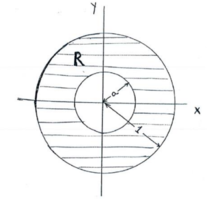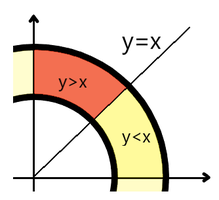Let the following function of two variables be:
f(x,y)={∣x∣ si (x,y)∈R0 otherwise
where R is the hatched area of Figure 2 (that is, the circular crown formed by the two circles with center (0,0) and radii a and 1, respectively).\\
a)-What must be the value of a for f(x,y) to be a function of the density of a continuous random variable (X,Y)?\\
b)- Calculate P(Y≥ X|X≥0).\\
c)- Find the marginal density functions fx(x) y fy(y).\\
d)- Using the results obtained in the previous section, reason if X and Y are independent random variables.

-----------------------------------------------------------------------
I want to know if my solutions for parts a) and b) are correct, and how do I do the c) and d)?
a)
∫Rf(x,y)dxdy=1⟹∫R∣x∣dxdy=∫02π∫a1r∣rcosθ∣drdθ==4\int_{0}^{\pi/2}\text{cos}\theta d\theta\int_a^1r^2 dr=4\left[\frac{r^3}{3}\right]_a^1=\frac{4}{3}\left(1-a^3\right)=1\Longrightarrow \boxed{a=\left(\frac{1}{4}\right)^{1/3}}
b) If I do it in polar coordinates, I'm assuming I have to work in that sector:

P(Y≥X∣X≥0)=∫∫∣x∣dxdy=∫π/4π/2∫a1r2cosθdrdθ=21[3r3]a1=61(1−41)=243=81
f(x,y)={∣x∣ si (x,y)∈R0 otherwise
where R is the hatched area of Figure 2 (that is, the circular crown formed by the two circles with center (0,0) and radii a and 1, respectively).\\
a)-What must be the value of a for f(x,y) to be a function of the density of a continuous random variable (X,Y)?\\
b)- Calculate P(Y≥ X|X≥0).\\
c)- Find the marginal density functions fx(x) y fy(y).\\
d)- Using the results obtained in the previous section, reason if X and Y are independent random variables.

-----------------------------------------------------------------------
I want to know if my solutions for parts a) and b) are correct, and how do I do the c) and d)?
a)
∫Rf(x,y)dxdy=1⟹∫R∣x∣dxdy=∫02π∫a1r∣rcosθ∣drdθ==4\int_{0}^{\pi/2}\text{cos}\theta d\theta\int_a^1r^2 dr=4\left[\frac{r^3}{3}\right]_a^1=\frac{4}{3}\left(1-a^3\right)=1\Longrightarrow \boxed{a=\left(\frac{1}{4}\right)^{1/3}}
b) If I do it in polar coordinates, I'm assuming I have to work in that sector:

P(Y≥X∣X≥0)=∫∫∣x∣dxdy=∫π/4π/2∫a1r2cosθdrdθ=21[3r3]a1=61(1−41)=243=81
